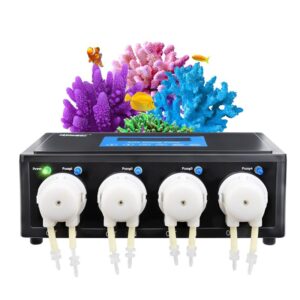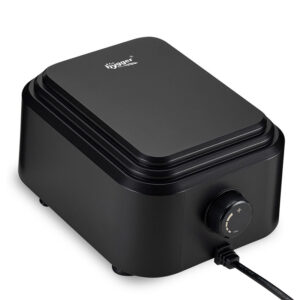Algae, such as black beard algae, blue-green algae, and chladophora, should be removed from your tank. As we have mentioned the main methods to get rid of algae, a bio solution is one of them. In this article, we will get into deep exploring about algae eating shrimp, especially Amano shrimp.
Content Table
Do shrimp eat algae
Do shrimp eat algae? This part will give you an overview of algae eating shrimp. After reading, you can know more about shrimp that regard algae as a food source.
1. Amano shrimp (Caridina multidentata/Caridina japonica/Japanese swamp shrimp)
Amano shrimp are transparent and have dark spots or dashes on both sides of their bodies. Besides, there are also shades of green or light brown on their bodies. And they can grow up to 2 inches. Amano shrimp can make sense in removing most algae, including black beard algae and hair algae.
2. Chinese grass shrimp
Chinese grass shrimp are translucent. And there are black strips as intervals. The stripes on the waist are the thickest. Chinese grass shrimp can remove filamentous algae. Meanwhile, they are peaceful and can get along well with Amano shrimp. However, they may eat some aquatic plants, for example, fescue. Therefore, you can introduce Chinese grass shrimp until the aquatic plants thrive.
3. Dwarf shrimp
Dwarf shrimp prefer hair algae and brush algae. However, they do not eat black beard algae. Keeping Dwarf shrimp with a few snails is feasible, but keeping them single is better. Besides, Dwarf shrimp are cheap and can reproduce quickly.
Cherry shrimp are one kind of Dwarf shrimp. They are omnivores and like eating soft green algae and green hair algae, but they do not eat blue-green algae and staghorn algae. Cherry shrimp spend their whole day eating algae if they can find algae.

4. Ghost shrimp
Ghost shrimp are similar to Amano shrimp in appearance, however, the two are different. While the Ghost shrimp are also translucent, they do not have spots on one side of their bodies. Ghost shrimp are great algae eating shrimp. They eat most algae, hair algae, and brush algae for example. Ghost shrimp can remove algae on the bottom of your tank, also, they can clean the algae on aquatic plants and aquarium decorations. Nonetheless, if there are other food sources, they will go for the food sources first. Moreover, Ghost shrimp are cheap and easy to breed.
5. Crystal red shrimp (CRS)
Crystal red shrimp are also famous as Caridina shrimp. Compared with Cherry shrimp, Crystal red shrimp is harder to keep. They prefer acidic water and hair algae.
6. Malawi shrimp (Caridina pareparensis parvidentata)
Malawi shrimp are found on Sulawesi island. They are easier to keep and breed than the Sulawesi shrimp. Malawi shrimp are hardy as well as peaceful, and they will eat most algae. Furthermore, Malawi shrimp are an excellent option for community fish tanks.
7. Sulawesi shrimp
Sulawesi shrimp are found on the Indonesian island, which is also famous as Caridina dennerli. They like algae, hair algae, and brush algae for instance. However, Sulawesi shrimp are not easy to keep and require particular water parameters, which makes them unideal for most community aquariums. Cardinal shrimp is one kind of Sulawesi shrimp. They can easily remove algae from your aquarium.

3 best algae eating shrimps
Next, we will dive into a more specific discussion about the three best algae eating shrimp, including Amano shrimp, Chinese grass shrimp, and Cherry shrimp.
Exactly, Amano shrimp are the most effective algae eating shrimp, which do best in removing different types of algae, including red algae, black beard algae, hair algae, green dust algae, green spots algae, and brown diatoms algae. Next, Chinese grass shrimp is ranking second. They can play an important role in eliminating filamentous algae. Cherry shrimp can also do a good job. They require low maintenance and are easy to breed. By the way, some physical methods can help them to remove algae better, we can apply aquarium magnet cleaner or algae scraper while adding these algae-eating shrimp.
Why did Amano shrimp die?
In this segment, we will learn why did Amano shrimp die and some care tips about Amano shrimps.
1. Death causes
| Causes | Detailed explanation |
| High temperature | The ideal temperature is 50-86℉ (10-30℃). Once the temperature is higher than 100℉, Amano shrimp may suffer death. |
| Temperature difference | Amano shrimp can not adapt to the temp before and after introducing. Besides, changing much water also causes temperature differences. |
| Oxygen deficit | High temperature, poor water quality, and rainy days are reasons for oxygen deficit. |
| Jump out of your tank | Provided that fish prefer eating Amano shrimp, and the shrimp have no hiding places, Amano shrimp will jump out of tanks. Aside from that, they will also jump out of your aquarium because of oxygen deficit and poor water quality. |
In summary, temperature difference and oxygen deficit are two main shrimps’ death reasons. Consequently, you should be careful when introducing shrimp and changing water. In winter, you can apply an aquarium heater and thermometer to maintain a stable water temperature and check the real-time.
For another thing, it is feasible to add an air pump to create oxygen and keep plenty of oxygen in your tank. Moreover, a water pump will help you cycle the water as well as remove excess waste and toxic substances, such as ammonia, nitrates, and nitrites. By doing so, your aquarium can maintain good water quality for shrimp to thrive.

2. Care tips for Amano shrimp
Aside from the causes mentioned above, on the other hand, we will cover some care tips for you.
- Water temperature
If the water temperature is lower than 50℉, their reproduction will get a bad impact, and they even lose interest in eating. On the contrary, high water temperatures also pose a threat to Amano shrimp. Therefore, you should keep the accepted water temperature of 50-86 ℉. By the way, you should also avoid sudden fluctuations in water temperature.
- Water quality
High ammonia and nitrate levels will directly lead to the death of Amano shrimp. Thus, it is essential to keep great and stable water quality.
- Tank mates
To avoid the attack from other creatures, keeping the Amano shrimp with some peaceful fish is an excellent option. In addition, it is also essential to create hiding places for Amano shrimp. Or they may be eaten easily when shelling.
- Daily maintenance
Before introducing Amano shrimp to your tank, it is better to test the water with the aquarium water test kit. Besides that, you can add some minerals to your tank. Meanwhile, you should make sure that the water does not contain pharmaceuticals or pigment.
- How many Amano shrimp are in a fish tank
| Tank size(length) | Recommended number |
| 10 cm | 5 |
| 20 cm | 10 |
| 30 cm | 20-30 |
| 40 cm | 50 |
| 50-100 cm | 50-200 |
Reminder
Until now, have you possessed a deeper understanding of algae eating shrimp? Nonetheless, you should be cautious when adding them to your tank. It is better to check the compatibility between shrimp and fish in your aquarium. Take Amano shrimp as an example, the ideal tank mates are Cory catfish, Chery shrimp, and Ghost shrimp. Nevertheless, Goldfish, Betta fish, and Crayfish are not recommended to keep with Amano shrimp.
Any other ideas? Welcome to share with us and leave them in the comment. Finally, thanks for your reading!


Leave a comment